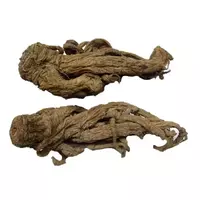Lovestock root

Medicinal amateur or Levisticum officinale belongs to the genus of perennial ratifications from the Umbrella family. Green leaves and lovestock root are eaten. In addition, the root of love is considered a well-known ingredient in healing infusions and drugs, which have been used in folk medicine for centuries. The useful properties of the root of the lover were known in ancient times. Even then, from the rhizome of a lover, they began to receive essential oil, which was used in homeopathy.
Archaeologists have found medical books that were dated to the early Middle Ages, which described recipes for medicinal baths based on decoction from the root of a lover. In addition to essential oil, the chemical composition of the lubistok root is enriched with potassium salts and other useful natural compounds. Lovestock root is used both fresh and dried. Fresh root is commonly used in sauces, marinds or salads. Often, lovestock root is added to meat and fish dishes.
In dried form, lovistok root is used as a spice and seasoned with soups, as well as vegetable, meat and fish dishes. Lovestock root is thought to combine perfectly with game meat. Lovestock root spice can be easily made at home. You just need to buy a fresh love root and dry, and then grind in a blender. The resulting spice will differ in a rich taste and aroma, somewhat similar to celery. It is better to store homemade seasoning from the love root in a glass jar, under a closed lid in a dry and cool place.
In our latitudes, lovestock root is considered a drug rather than a culinary ingredient. Therefore, it is not surprising that in most pharmacies it is possible to purchase powder or whole dried lovestock root. From the root of a lover, healing, vitamin and general strengthening decoctions and infusions can be made. Lovestock root, like other components of plants, are considered important components of the therapeutic menu for diseases of the gastrointestinal tract.
It is believed that eating lovistok root every day will help to establish metabolic and digestive processes in the human body. However, in addition to the exceptional benefits of the root of love, the product has its own contraindications. Firstly, do not use lovers to people suffering from individual intolerance to the plant. Secondly, gynecologists strongly advise to avoid eating lovistok for pregnant women and breastfeeding mothers.
In the first case, the substances contained in the root of the lover can harm the development of the future baby, as well as provoke a miscarriage. During breastfeeding, lovestock root can trigger persistent allergic reactions in the baby. In any case, before eating new foods or medicines, it is better to consult a doctor and, if necessary, undergo a medical examination.
love root 20 kKal
Energy value of the root of love (Ratio of proteins, fats, carbohydrates - ju):
Proteins: 3.7 g (~ 15 kCal)
Fats: 0.4 g (~ 4 kCal)
Carbohydrates: 7.6 g (~ 30 kCal)
Energy ratio (bj | y): 74% | 18% | 152%
 Español
Español Français
Français Português
Português Русский
Русский 简体中文
简体中文 繁體中文
繁體中文 日本語
日本語 한국어
한국어 العربية
العربية Türkçe
Türkçe Қазақ
Қазақ Deutsch
Deutsch Italiano
Italiano Українська
Українська
